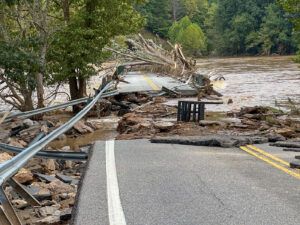The planet has just finished its hottest decade on record, leaving municipalities and businesses wondering how best to prepare for the future. As climate change increases the frequency and intensity of both extreme weather events like storms and heat waves, and chronic stresses like drought and sea level rise, the past is no longer an accurate prediction of the present.
While Canada’s latitude and geography makes it less exposed to widespread threats such as heat stress and hurricanes, its exposure to water stress and floods, alongside its economic dependency on water-heavy industries such as extraction, refining and manufacturing, does present significant risks. From striving to keep their residents safe, to supporting regional businesses, maintaining economic prosperity and minimizing costs, there are many reasons that municipal leaders need to understand and prepare for climate impacts.
This article outlines how climate risk presents economic risks to municipalities, as well as the investors with assets in the jurisdictions, and describes case studies of economic risk exposure in Canadian cities.
Why it Matters
Climate change poses economic risks to municipalities by impacting key companies, reducing the tax base, and affecting the budget. When companies that make up significant portions of a municipality’s economy — by way of revenue, taxes and employment — are disrupted by climate change, this has negative implications for the municipality. If these events happen repeatedly, it’s likely that jobs and, potentially the population, will decline, reducing the municipality’s revenue from taxes.
For example, low snowfall and a record dry summer in 2013 and 2014 led to reduced hydropower generation in Canada’s Northwest Territories, with implications for businesses with high power demands such as manufacturing and mining. These industries make up significant portions of Canada’s economy and an increase in water stress is likely to have enduring impacts.
Extreme weather events also lead to increased costs for municipalities in the form of emergency relief and rebuilding. For example, in Spring 2019 thousands were evacuated during flooding in Eastern Canada due to high snow melt combined with heavy rainfall, with costs expected to be in the hundreds of millions. At the time there was relatively low overland flood insurance coverage, so there were significant uninsured costs. These events also disrupt transit infrastructure, with implications for commutes and regional business operations.
Increasing expenditures on emergency relief can have implications for municipalities’ other budget items, debt reserves and ultimately their ability to repay loans. Likewise, persistent regional disruptions can have material impacts on businesses with key assets in the area.
Economic Climate Risk Exposure in Canada
Mining and extraction, construction, manufacturing and real estate are crucial industries in Canada’s economy and are also particularly vulnerable to climate impacts due to their heavy dependency on water and energy and their reliance on specific locations and outdoor operations.
In Alberta Canada, home to Calgary and Edmonton— two of the largest five cities in the nation—mining and extraction contribute 17 percent of GDP, real estate, rental and leasing contribute 12 percent, and construction and manufacturing each contribute nine percent. This region is particularly exposed to water stress, which poses risks to water intensive operations such as mining and extraction, as well as energy intensive operations dependent on water for cooling such as some manufacturing facilities.
Four Twenty Seven collates a database of over a million corporate facilities globally and integrates several climate and environmental datasets to score the facilities on their exposure to climate hazards looking out to mid-century.
Out of 1751 facilities from Four Twenty Seven’s database that are in Calgary, 1221, or about 70 percent, have at least high risk to water stress. Two hundred of these facilities are associated with Oil, Gas and Consumable Fuels, which can be highly dependent on water for their drilling and processing. Forty-three industrial facilities have at least high risk of water stress, which can pose risks to chemical and refining facilities that rely on water. Likewise, 30 chemical facilities are exposed.

Figure 1. Water Stress in Calgary, AB. Dots represent facilities, colored based on their exposure to water stress, with darker facilities more exposed. Source: Four Twenty Seven
The exposure of large numbers of sensitive facilities to water stress has implications for Calgary and other jurisdictions with similar exposure. If water stress becomes severe, the city may have to consider mandating restrictions, which would require challenging decisions on how to promote the continued success of key industries, while maintaining sustainable water resources.
In 2017, in Vancouver, BC, finance, insurance and real estate contributed 31 percent to the economy, construction contributed nine percent, manufacturing eight percent and transportation and warehousing contributed seven percent. While finance, banks, and insurance are largely exposed to the impacts of climate change through the exposure of the assets in which they invest, rather than the exposure of their own office buildings, real estate is vulnerable to direct climate impacts, such as increased repair and insurance costs and reduced asset value. For example, in the United States, properties exposed to sea level rise are selling at a seven percent discount compared to less exposed properties.
Sea level rise can lead to exacerbated flooding during storms, as well as increased instances of flooding during high-tides. This can damage facilities and disrupt operations, but also has far-reaching regional implications for transportation, energy and communication infrastructure. For municipalities, exposure to sea level rise presents long-term challenges around considering if transportation nodes will become inaccessible over time and assessing where redundancy is built-in, so key assets such as hospitals, airports, telecommunications and corporate facilities will be accessible in case of flooding.

Figure 2. Sea Level Rise in Vancouver, BC. Dots represent facilities, coloured based on their exposure to sea level rise, with red facilities more exposed. Source: Four Twenty Seven.
All 58 transportation, communications, electric, gas and sanitary service facilities included in our data for Vancouver have medium or higher exposure to sea level rise, which is significant given the importance of these assets. Likewise, retail trade facilities make up 25 percent of the facilities assessed in Vancouver, and all 218 retail trade facilities have medium or higher exposure to sea level rise.
In Annapolis, Maryland, sunny day flooding reduced visits to the historic downtown by 1.7 percent, leading to lost revenue. Sea level rise of three and 12 inches are expected to reduce visits by 3.6 percent and 24 percent respectively.
Floods have similar far-reaching impacts as sea level rise are increasing in frequency and severity throughout Canada. In Toronto, which faced significant flooding several times in 2019, 22 manufacturing facilities, 29 transportation, communications, electric, gas and sanitary service facilities and 99 retail trading facilities have at least medium exposure to flood risk. While these are small percentages of the 1648 assessed facilities in Toronto, they represent important economic contributors which could be severely impacted by increasing instances of costly flood events.
Addressing Climate Risk
Understanding their risk exposure helps municipalities, corporations and investors manage risk over time. Municipalities can invest in resilience measures to reduce the impacts of climate hazards. However, this requires budget adjustments and significant upfront planning to reduce future costs. Toronto’s Resilience Plan acknowledges the need to raise funds through grants and other sources, highlighting the financial challenges in preparing for climate change.
In addition to funding challenges, effective resilience measures require forward-looking climate risk assessment and an understanding of regional vulnerabilities to relevant climate hazards. When investors, businesses and municipalities engage around shared risks and resilience priorities, they can leverage respective strengths and partner to more effectively assess and reduce risks and build resilience. For example, the City of Toronto has a Flood Resilience Working Group with members from city divisions, agencies, government ministries and also the private sector which is engaging around understanding flood risk and building resilience in the area, including obtaining funds for capital projects.

Figure 3. Floods in Toronto, ON. Dots represent facilities, colored based on their exposure to floods with red facilities most exposed. Source: Four Twenty Seven.
For infrastructure developers and investors, it is essential to integrate forward-looking climate risks into all steps of the development process, acknowledging the long life-cycle of infrastructure projects. These assets can be affected by climate risk in many ways including increasing utility and repair costs, shifting consumer commutes and the associated reduced revenue for assets such as toll bridges. The Province of Ontario mandates that
all cities integrate climate vulnerability into their infrastructure planning, which can help to minimize the costs over time.
Lastly, it is important for key sectors of the economy, such as real estate, refining and manufacturing, to identify climate adaptation opportunities. For example, manufacturing and other high-energy companies that rely on hydropower can examine alternative energy sources and water-intensive refineries can review ways to use less water. California’s East Bay Municipal Utility District provides municipal effluent to industry to use instead of freshwater, which demonstrates one way in which municipalities can work with their key industries to safeguard water resources and build resilience.
Municipalities’ economic vulnerability to climate impacts depends on many elements including the climate risk exposure and sensitivity of key assets in the regions. This likewise has implications for the businesses that rely on these facilities and the investors that invest in the municipality and real assets in the area. Understanding how specific climate risks may affect their own assets enables municipalities, investors and corporations to better prepare for impacts and to engage across sectors to build collaborative economic resilience.
NATALIE AMBROSIO is a climate adaptation specialist and science communicator, distilling technical information into actionable insights on climate risk and resilience across sectors. At Four Twenty Seven, Natalie manages communications and thought leadership initiatives, writing on climate change’s economic impacts, strategies for financial actors to assess and manage risk, and the interconnected nature of climate resilience. Previously, Natalie helped develop an assessment of U.S. cities’ vulnerabilities to climate change and their readiness to adapt, at the Notre Dame Global Adaptation Initiative (ND-GAIN).



